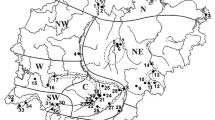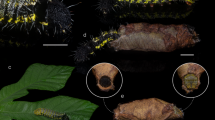Abstract
Parasitoidism is a key innovation in insect evolution, and parasitoid insects, nowadays, play a significant role in structuring ecological communities. Despite their diversity and ecological impact, little is known about the early evolution and ecology of parasitoid insects, especially parasitoid true flies (Diptera). Here, we describe a bizarre fly, Zhenia xiai gen. et sp. nov., from Late Cretaceous Burmese amber (about 99 million years old) that represents the latest occurrence of the family Eremochaetidae. Z. xiai is an endoparasitoid insect as evidenced by a highly developed, hypodermic-like ovipositor formed by abdominal tergites VIII + IX that was used for injecting eggs into hosts and enlarged tridactylous claws supposedly for clasping hosts. Our results suggest that eremochaetids are among the earliest definite records of parasitoid insects. Our findings reveal an unexpected morphological specialization of flies and broaden our understanding of the evolution and diversity of ancient parasitoid insects.




Similar content being viewed by others
References
Beckage NE (1985) Endocrine interactions between endoparasitic insects and their hosts. Annu Rev Entomol 30:371–413
Boucot AJ, Poinar JG (2010) Fossil behavior compendium. CRC Press, Boca Rato
Brodeur J, Boivin G (2004) Functional ecology of immature parasitoids. Annu Rev Entomol 49:27–49
Buschbeck E, Strausfeld J (1997) The relevance of neural architecture to visual performance: phylogenetic conservation and variation in Dipteran visual systems. J Comp Neurol 383:282–304
Chen J, Wang B, Engel MS, Wappler T, Jarzembowski EA, Zhang HC, Wang XL, Zheng XT, Rust J (2014) Extreme adaptations for aquatic ectoparasitism in a Jurassic fly larva. eLife 3:e02844
Eggleton P, Belshaw R (1992) Insect parasitoids: an evolutionary overview. Proc R Soc B 337:1–20
Eggleton P, Belshaw R (1993) Comparison of dipteran, hymenopteran, and coleopteran parasitoids: provisional phylogenetic explanations. Biol J Linn Soc 48:213–226
Feener DH, Brown BV (1997) Diptera as parasitoids. Annu Rev Entomol 42:73–97
Gilbert FS, Jervis MA (1998) Functional, evolutionary and ecological aspects of feeding-related mouthpart specializations in parasitoid flies. Biol J Linn Soc 63:495–535
Godfray HCJ (1994) Parasitoids: behavioral and evolutionary ecology. Princeton Univ Press, Princeton
Grimaldi DA, Engel MS (2005) Evolution of the insects. Cambridge Univ Press, New York
Grimaldi DA, Kathirithamby J, Schawaroch V (2005) Strepsiptera and triungula in Cretaceous amber. Insect Syst Evol 36:1–20
Grimaldi DA, Arillo A, Cumming JM, Hauser M (2011) Brachyceran Diptera (Insecta) in Cretaceous ambers, part IV, significant new Orthorrhaphous taxa. ZooKeys 148:293–332
Gross P (1993) Insect behavioral and morphological defenses against parasitoids. Annu Rev Entomol 38:251–273
Heraty J (2009) Parasitoid biodiversity and insect pest management, Insect biodiversity: science and society. Blackwell Publishing, Oxford, pp 445–462
Hong YC (1983) Middle Jurassic fossil insects in North China. Geological Publishing House, Beijing
Kovalev VG (1989) Bremochaetidae, the Mesozoic family of brachycerous dipterans. Paleontol J 1989(2):100–105
Labandeira CC (2002) Paleobiology of predators, parasitoids, and parasites: death and accommodation in the fossil record of continental invertebrates. Paleontol Soc Pap 8:211–250
Lambkin CL, Sinclair BJ, Pape T, Courtney GW, Skevington JH, Meier R, Yeates DK, Blagoderov V, Wiegmann BW (2013) The phylogenetic relationships among infraorders and superfamilies of Diptera based on morphological evidence. Syst Entomol 38:164–179
Leung TLF (2015) Fossils of parasites: what can the fossil record tell us about the evolution of parasitism? Biol Rev. doi:10.1111/brv.12238
Mostovski MB (1996) To the knowledge of Archisargoidea (Diptera, Brachycera). Families Eremochaetidae and Archisargidae. Russ Entomol J 5:117–124
Myskowiak J, Azar D, Nel A (2015) The first fossil hilarimorphid fly (Diptera: Brachycera). Gondwana Res. doi:10.1016/j.gr.2015.05.003
Olmi M (1984) A revision of the Dryinidae (Hymenoptera). Mem Am Entomol Inst 37:17–947
Peñalver E, Arillo A, Riccio ML, Pérez-De La Fuente R, Delclòs X, Barrón E, Grimaldi DA (2015) Long-proboscid flies as pollinators of Cretaceous gymnosperms. Curr Biol 25:1917–1923
Pritchard G (1983) Biology of Tipulidae. Annu Rev Entomol 28:1–22
Ronquist F, Klopfstein S, Vilhelmsen L, Schulmeister S, Murray DL, Rasnitsyn AP (2012) A total-evidence approach to dating with fossils, applied to the early radiation of the Hymenoptera. Syst Biol 61:973–999
Ross A, Mellish C, York P, Crighton B (2010) Chapter 12. Burmese amber. In: Penney D (ed) Biodiversity of fossils in amber from the major world deposits. Siri Scientific Press, Manchester, pp 208–235
Shi G, Grimaldi DA, Harlow GE, Wang J, Wang J, Yang M, Lei W, Li Q, Li X (2012) Age constraint on Burmese amber based on U-Pb dating of zircons. Cretac Res 37:155–163
Skevington JH, Dang PT (2002) Exploring the diversity of flies (Diptera). Biodiversity 3:3–27
Stireman O III (2006) Tachinidae: evolution, behavior, and ecology. Annu Rev Entomol 51:525–555
Stoffolano JG Jr, Yin LRS (1987) Structure and function of the ovipositor and associated sensilla of the apple maggot, Rhagoletis pomonella (Walsh) (Diptera: Tephritidae). Int J Insect Morphol Embryol 16:41–69
Ussatchov DA (1968) New Jurassic Asilomorpha (Diptera) in Karatau. Entomol Rev 47:617–628
Vinson SB, Iwantsch GF (1980) Host regulation by insect parasitoids. Q Rev Biol 55:143–165
Wajnberg É, Bernstein C, van Alphen J (2008) Behavioral ecology of insect parasitoids: from theoretical approaches to field applications. Blackwell Publishing Ltd, Oxford
Whitfield JB (1998) Phylogeny and evolution of host-parasitoid interactions in Hymenoptera. Annu Rev Entomol 43:129–151
Wiegmann BM, Trautwein MD, Winkler IS, Barr NB, Kim J-W, Lambkin C, Bertone MA, Cassel BK, Bayless KM, Heimberg AM, Wheeler BM, Peterson KJ, Pape T, Sinclair BJ, Skevington JH, Blagoderov V, Caravas J, Kutty SN, Schmidt-Ott U, Kampmeier GE, Thompson FC, Grimaldi DA, Beckenbach AT, Courtney GW, Friedrich M, Meier R, Yeates DK (2011) Episodic radiations in the fly tree of life. Proc Natl Acad Sci U S A 108:5691–5695
Yeates DK (2002) Relationships of extant lower Brachycera (Diptera): a quantitative synthesis of morphological characters. Zool Scr 31:105–121
Zhang JF (2014a) New male eremochaetid flies (Diptera, Brachycera, Eremochaetidae) from the Lower Cretaceous of China. Cretac Res 49:205–221
Zhang JF (2014b) Archisargoid flies (Diptera, Brachycera, Archisargidae and Kovalevisargidae) from the Jurassic Daohugou biota of China, and the related biostratigraphical correlation and geological age. J Syst Palaeontol 13:857–881
Zhang KY, Yang D, Ren D (2014) New short-horned flies (Diptera: Eremochaetidae) from the Early Cretaceous of China. Zootaxa 3760:479–486
Acknowledgments
We are grateful to Prof. E.A. Jarzembowski for improving the English language of the manuscript and Mr. D.H. Yang for the reconstruction drawing. This research was supported by the National Basic Research Program of China (2012CB821900), National Natural Science Foundation of China (41572010, J1210006), and Youth Innovation Promotion Association of CAS (No. 2011224).
Author information
Authors and Affiliations
Corresponding author
Additional information
Communicated by: Sven Thatje
Rights and permissions
About this article
Cite this article
Zhang, Q., Zhang, J., Feng, Y. et al. An endoparasitoid Cretaceous fly and the evolution of parasitoidism. Sci Nat 103, 2 (2016). https://doi.org/10.1007/s00114-015-1327-y
Received:
Revised:
Accepted:
Published:
DOI: https://doi.org/10.1007/s00114-015-1327-y




